DODGE SPRINTER 2006 1.G Owners Manual
Manufacturer: DODGE, Model Year: 2006, Model line: SPRINTER, Model: DODGE SPRINTER 2006 1.GPages: 330, PDF Size: 10.82 MB
Page 171 of 330
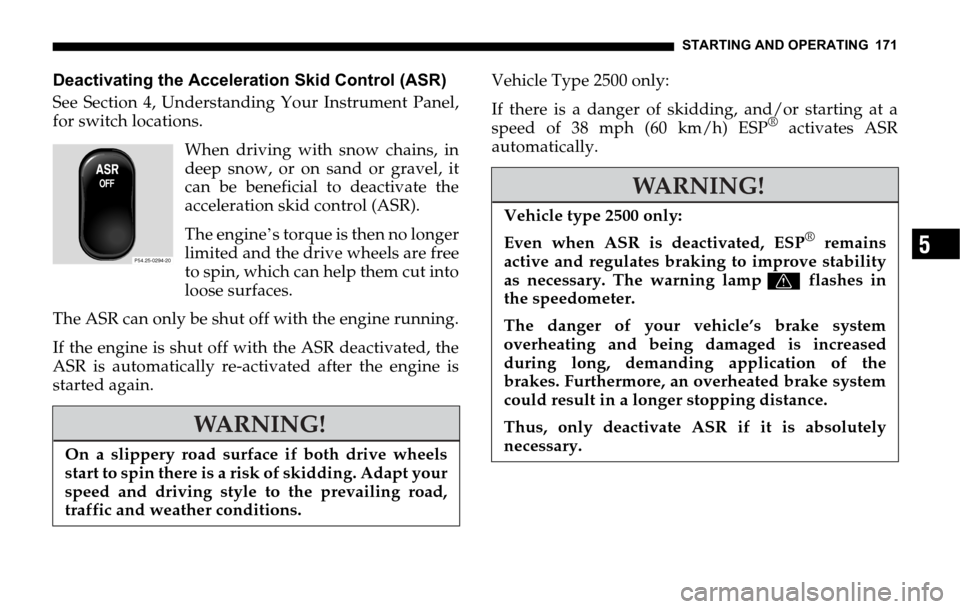
STARTING AND OPERATING 171
5
Deactivating the Acceleration Skid Control (ASR)
See Section 4, Understanding Your Instrument Panel,
for switch locations.
When driving with snow chains, in
deep snow, or on sand or gravel, it
can be beneficial to deactivate the
acceleration skid control (ASR).
The engine’s torque is then no longer
limited and the drive wheels are free
to spin, which can help them cut into
loose surfaces.
The ASR can only be shut off with the engine running.
If the engine is shut off with the ASR deactivated, the
ASR is automatically re-activated after the engine is
started again.Vehicle Type 2500 only:
If there is a danger of skidding, and/or starting at a
speed of 38 mph (60 km/h) ESP
® activates ASR
automatically.
WARNING!
On a slippery road surface if both drive wheels
start to spin there is a risk of skidding. Adapt your
speed and driving style to the prevailing road,
traffic and weather conditions.
P54.25-0294-20
WARNING!
Vehicle type 2500 only:
Even when ASR is deactivated, ESP
® remains
active and regulates braking to improve stability
as necessary. The warning lampv flashes in
the speedometer.
The danger of your vehicle’s brake system
overheating and being damaged is increased
during long, demanding application of the
brakes. Furthermore, an overheated brake system
could result in a longer stopping distance.
Thus, only deactivate ASR if it is absolutely
necessary.
Page 172 of 330

172 STARTING AND OPERATING
To deactivate the ASR:
Press the upper section of the switch – the warning
lamp v in the speedometer lights up.
Traction control continues to cut in if, for example, a
wheel on one side of the vehicle reaches its limit of
adhesion. The wheel is then braked to increase the
vehicle’s overall traction.
The warning lamp v will flash in the speedometer
at any speed when a tire reaches its limit of adhesion
and spins.
To activate the ASR:
Press the upper section of the switch again – the
warning lamp v in the speedometer goes out.Brake Assist System (BAS) (vehicle type 2500 only)
The Brake Assist System (BAS) operates in emergency
situations. If you apply the brakes very quickly, the
BAS automatically provides full brake boost, thereby
potentially reducing braking distance.
Apply continuous full braking pressure until the
emergency braking situation is over.
The ABS will prevent the wheels from locking.
When you release the brake pedal, the brakes function
again as normal. The BAS is then deactivated.
WARNING!
If the indicator lamp k remains on, a malfunc-
tion may not only have occurred in the ASR sys-
tem but also in the BAS.
The handling and braking characteristics of your
vehicle change. Drive with extra caution.
Have the malfunction traced and repaired as soon
as possible by an authorized Sprinter Dealer.
Page 173 of 330
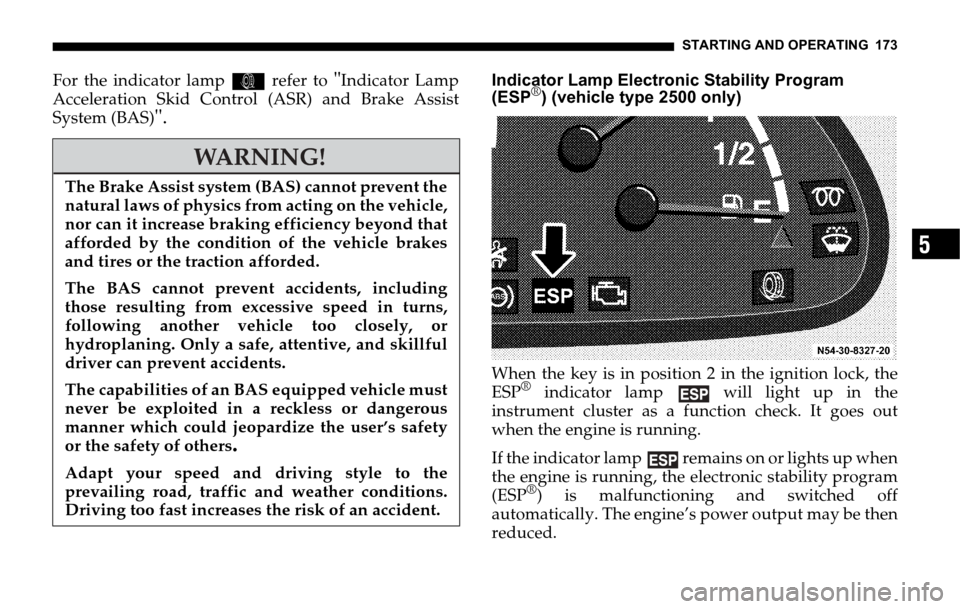
STARTING AND OPERATING 173
5
For the indicator lamp k refer to "Indicator Lamp
Acceleration Skid Control (ASR) and Brake Assist
System (BAS)
".
Indicator Lamp Electronic Stability Program
(ESP®) (vehicle type 2500 only)
When the key is in position 2 in the ignition lock, the
ESP
® indicator lamp will light up in the
instrument cluster as a function check. It goes out
when the engine is running.
If the indicator lamp remains on or lights up when
the engine is running, the electronic stability program
(ESP
®) is malfunctioning and switched off
automatically. The engine’s power output may be then
reduced.
WARNING!
The Brake Assist system (BAS) cannot prevent the
natural laws of physics from acting on the vehicle,
nor can it increase braking efficiency beyond that
afforded by the condition of the vehicle brakes
and tires or the traction afforded.
The BAS cannot prevent accidents, including
those resulting from excessive speed in turns,
following another vehicle too closely, or
hydroplaning. Only a safe, attentive, and skillful
driver can prevent accidents.
The capabilities of an BAS equipped vehicle must
never be exploited in a reckless or dangerous
manner which could jeopardize the user’s safety
or the safety of others
.
Adapt your speed and driving style to the
prevailing road, traffic and weather conditions.
Driving too fast increases the risk of an accident.
Page 174 of 330

174 STARTING AND OPERATING
NOTE: If the ABS is malfunctioning or the voltage in
the vehicle’s electrical system drops below 10 volts, the
indicator lamp will also light up in the instrument
cluster and the ESP
® will be deactivated. The indicator
lamp will go out as soon as the voltage reaches this
level again or the ABS is operational again – the ESP
®
is then reactivated.Electronic Stability Program (ESP
®) (vehicle type
2500 only)
The Electronic Stability Program (ESP
®) monitors the
vehicle’s traction (force of adhesive friction between
the tires and the road surface) and handling.
The ESP
® recognizes when a wheel is spinning or if the
vehicle starts to skid. By applying brakes to the
appropriate wheel and by limiting engine output, the
ESP
® works to stabilize the vehicle. The ESP® is
especially useful while driving off and on wet or
slippery road surfaces.
The warning lamp v in the speedometer flashes
when the ESP
® is engaged, refer also to "Warning
Lamp Acceleration Skid Control (ASR) and Electronic
Stability Program (ESP
®)".
If wheels with tires of a different size than those offered
by an authorized Sprinter Dealer are used, the correct
operation of the ESP
® cannot be guaranteed.
WARNING!
If the ESP® indicator lamp remains on, the
electronic stability program (ESP®) is malfunc-
tioning. The vehicle stability will no longer be au-
tomatically regulated in good time.
The danger that your vehicle breaks into a skid, is
increased in certain driving situations. Drive with
extra caution.
Have the ESP
® repaired as soon as possible by an
authorized Spinter Dealer.
Page 175 of 330
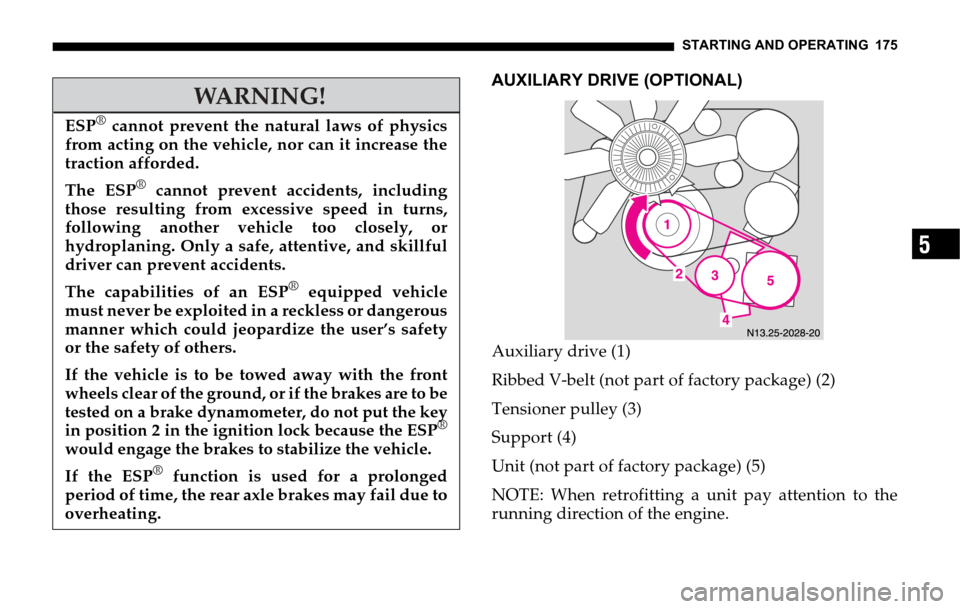
STARTING AND OPERATING 175
5
AUXILIARY DRIVE (OPTIONAL)
Auxiliary drive (1)
Ribbed V-belt (not part of factory package) (2)
Tensioner pulley (3)
Support (4)
Unit (not part of factory package) (5)
NOTE: When retrofitting a unit pay attention to the
running direction of the engine.
WARNING!
ESP® cannot prevent the natural laws of physics
from acting on the vehicle, nor can it increase the
traction afforded.
The ESP
® cannot prevent accidents, including
those resulting from excessive speed in turns,
following another vehicle too closely, or
hydroplaning. Only a safe, attentive, and skillful
driver can prevent accidents.
The capabilities of an ESP
® equipped vehicle
must never be exploited in a reckless or dangerous
manner which could jeopardize the user’s safety
or the safety of others.
If the vehicle is to be towed away with the front
wheels clear of the ground, or if the brakes are to be
tested on a brake dynamometer, do not put the key
in position 2 in the ignition lock because the ESP
®
would engage the brakes to stabilize the vehicle.
If the ESP® function is used for a prolonged
period of time, the rear axle brakes may fail due to
overheating.
Page 176 of 330
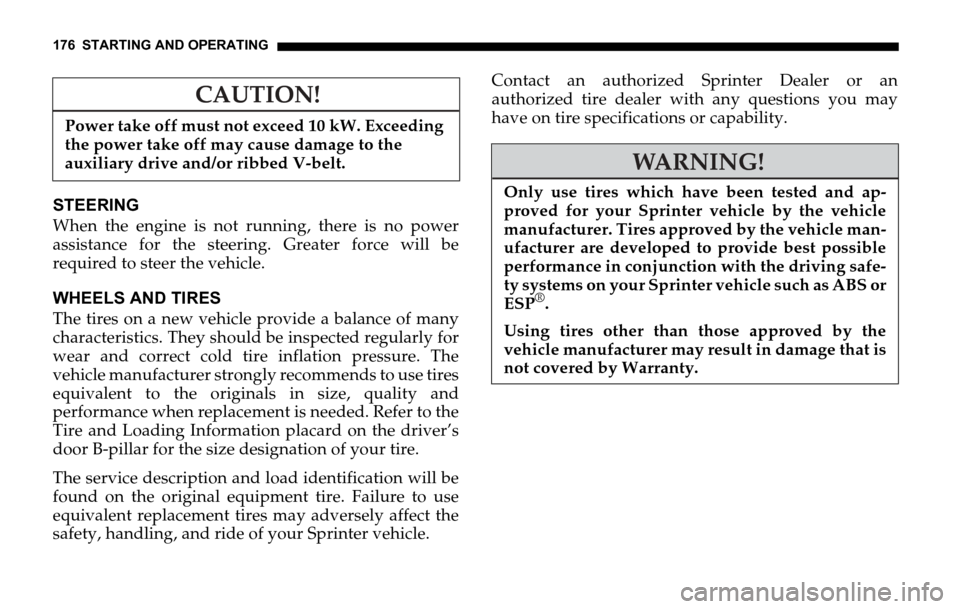
176 STARTING AND OPERATING
STEERING
When the engine is not running, there is no power
assistance for the steering. Greater force will be
required to steer the vehicle.
WHEELS AND TIRES
The tires on a new vehicle provide a balance of many
characteristics. They should be inspected regularly for
wear and correct cold tire inflation pressure. The
vehicle manufacturer strongly recommends to use tires
equivalent to the originals in size, quality and
performance when replacement is needed. Refer to the
Tire and Loading Information placard on the driver’s
door B-pillar for the size designation of your tire.
The service description and load identification will be
found on the original equipment tire. Failure to use
equivalent replacement tires may adversely affect the
safety, handling, and ride of your Sprinter vehicle.Contact an authorized Sprinter Dealer or an
authorized tire dealer with any questions you may
have on tire specifications or capability.
CAUTION!
Power take off must not exceed 10 kW. Exceeding
the power take off may cause damage to the
auxiliary drive and/or ribbed V-belt.
WARNING!
Only use tires which have been tested and ap-
proved for your Sprinter vehicle by the vehicle
manufacturer. Tires approved by the vehicle man-
ufacturer are developed to provide best possible
performance in conjunction with the driving safe-
ty systems on your Sprinter vehicle such as ABS or
ESP
®.
Using tires other than those approved by the
vehicle manufacturer may result in damage that is
not covered by Warranty.
Page 177 of 330

STARTING AND OPERATING 177
5
For more information on tire size designation, load and
speed rating, refer to "Tire Labeling". See an authorized
Sprinter Dealer for information on tested and
recommended rims and tires for summer and winter
operation. They can also offer advice concerning tire
service and purchase.
WARNING!
Using tires other than those approved by the vehi-
cle manufacturer can have detrimental effects,
such as
poor handling characteristics
increased noise
increased fuel consumption
Moreover, tires and rims not approved by the
vehicle manufacturer may, under load, exhibit
dimensional variations and different tire
deformation characteristics that could cause them
to come into contact with the vehicle body or axle
parts. Damage to the tires or the vehicle may be
the result.
WARNING!
Do not use a tire, wheel size or rating other than
that specified for your Sprinter vehicle. Some
combinations of unapproved tires and wheels
may change suspension dimensions and perfor-
mance characteristics, resulting in changes to
steering, handling, and braking of your Sprinter
vehicle. This can cause unpredictable handling
and stress to steering and suspension compo-
nents. You could lose control and have an accident
resulting in serious injury or death. Use only the
tire and wheel sizes with load ratings approved
for your Sprinter vehicle, refer to "Tire and Load-
ing Information". Never use a tire with a smaller
load index or speed index or capacity, other than
what was originally equipped on your Sprinter
vehicle. Using a tire with a smaller load index
could result in tire overloading and failure. You
could lose control and have an accident.
Failure to equip the vehicle with tires having
adequate speed capability can result in sudden
tire failure and loss of vehicle control.
Page 178 of 330
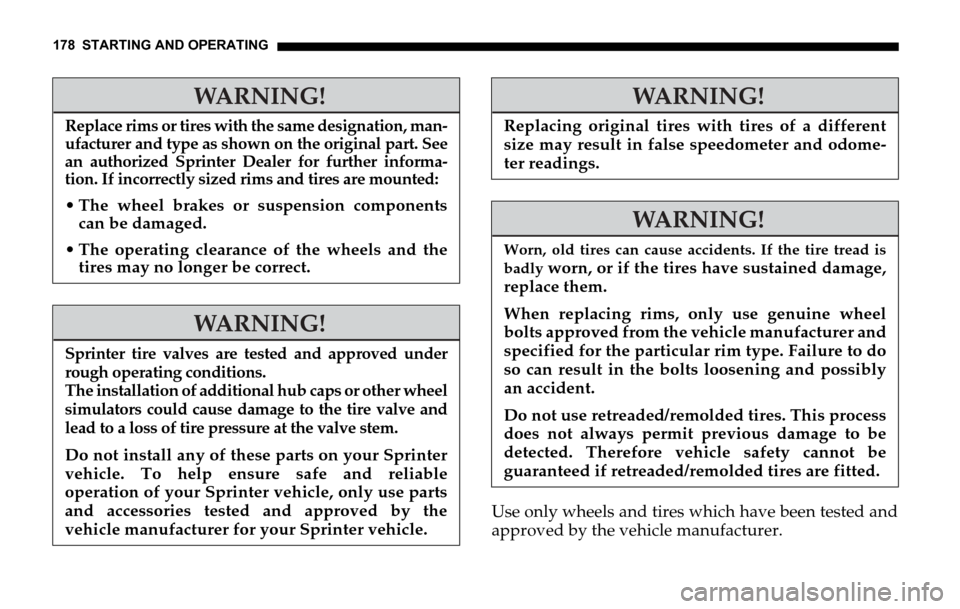
178 STARTING AND OPERATING
Use only wheels and tires which have been tested and
approved by the vehicle manufacturer.
WARNING!
Replace rims or tires with the same designation, man-
ufacturer and type as shown on the original part. See
an authorized Sprinter Dealer for further informa-
tion. If incorrectly sized rims and tires are mounted:
The wheel brakes or suspension components
can be damaged.
The operating clearance of the wheels and the
tires may no longer be correct.
WARNING!
Sprinter tire valves are tested and approved under
rough operating conditions.
The installation of additional hub caps or other wheel
simulators could cause damage to the tire valve and
lead to a loss of tire pressure at the valve stem.
Do not install any of these parts on your Sprinter
vehicle. To help ensure safe and reliable
operation of your Sprinter vehicle, only use parts
and accessories tested and approved by the
vehicle manufacturer for your Sprinter vehicle.
WARNING!
Replacing original tires with tires of a different
size may result in false speedometer and odome-
ter readings.
WARNING!
Worn, old tires can cause accidents. If the tire tread is
badly
worn, or if the tires have sustained damage,
replace them.
When replacing rims, only use genuine wheel
bolts approved from the vehicle manufacturer and
specified for the particular rim type. Failure to do
so can result in the bolts loosening and possibly
an accident.
Do not use retreaded/remolded tires. This process
does not always permit previous damage to be
detected. Therefore vehicle safety cannot be
guaranteed if retreaded/remolded tires are fitted.
Page 179 of 330
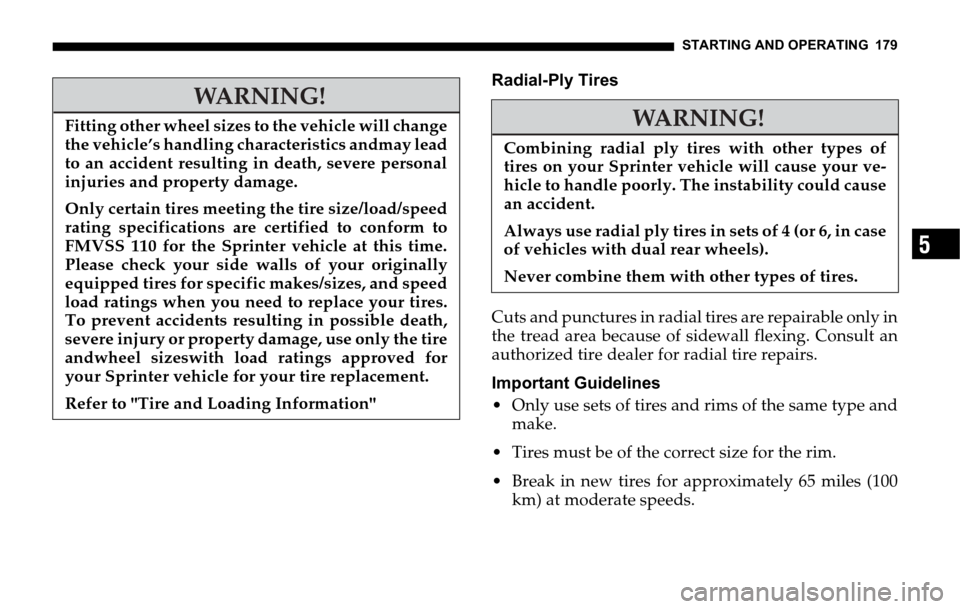
STARTING AND OPERATING 179
5
Radial-Ply Tires
Cuts and punctures in radial tires are repairable only in
the tread area because of sidewall flexing. Consult an
authorized tire dealer for radial tire repairs.
Important Guidelines
Only use sets of tires and rims of the same type and
make.
Tires must be of the correct size for the rim.
Break in new tires for approximately 65 miles (100
km) at moderate speeds.
WARNING!
Fitting other wheel sizes to the vehicle will change
the vehicle’s handling characteristics andmay lead
to an accident resulting in death, severe personal
injuries and property damage.
Only certain tires meeting the tire size/load/speed
rating specifications are certified to conform to
FMVSS 110 for the Sprinter vehicle at this time.
Please check your side walls of your originally
equipped tires for specific makes/sizes, and speed
load ratings when you need to replace your tires.
To prevent accidents resulting in possible death,
severe injury or property damage, use only the tire
andwheel sizeswith load ratings approved for
your Sprinter vehicle for your tire replacement.
Refer to "Tire and Loading Information"WARNING!
Combining radial ply tires with other types of
tires on your Sprinter vehicle will cause your ve-
hicle to handle poorly. The instability could cause
an accident.
Always use radial ply tires in sets of 4 (or 6, in case
of vehicles with dual rear wheels).
Never combine them with other types of tires.
Page 180 of 330

180 STARTING AND OPERATING
Regularly check the tires and rims for damage.
Dented or bent rims can cause tire inflation pressure
loss and damage to the tire beads.
If vehicle is heavily loaded, check tire inflation
pressure and correct as required.
Do not allow your tires to wear down too far.
Adhesion properties on wet roads are sharply
reduced at tread depths under 1/8 in (3 mm) for
summer tires and 1/6 in (4 mm) for winter tires.
When replacing individual tires, you should mount
new tires on the front wheels first.
Tire Care and MaintenanceThe tire inflation pressure should be checked
regularly, i.e. at least each time you refuel the vehicle.
The preferred interval for checking the tire inflation
pressure, however, is before each trip.
For more information on checking tire inflation
pressure, refer to "Recommended Tire Inflation
Pressure".
Tire Inspection
Every time when checking the tire inflation pressure,
the tires should also be inspected for the following:
excessive treadwear, refer to "Tread Depth"
cord or fabric showing through the tire’s rubber
bumps, bulges, cuts, cracks or splits in the tread or
side of the tire
Replace the tire if any of the above conditions is found.
Also inspect the spare tire periodically for condition
and inflation. Spare tires will age and become worn
over time even if never used, and thus should be
inspected and replaced when necessary.
WARNING!
Regularly check the tires for damage. Damaged
tires can cause tire inflation pressure loss. As a re-
sult, you could lose control of your Sprinter vehi-
cle.
Worn, old tires can cause accidents. If the tire
tread is badly worn, or if the tires have sustained
damage, replace them.